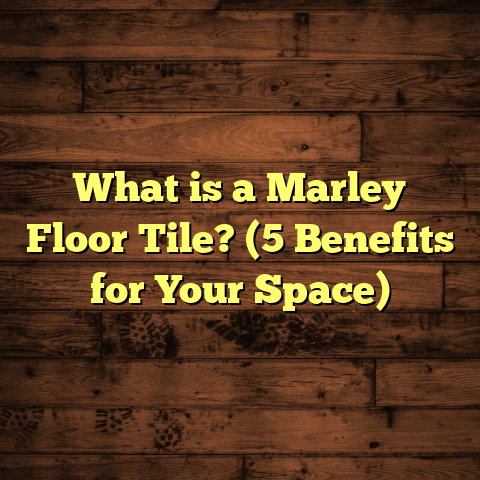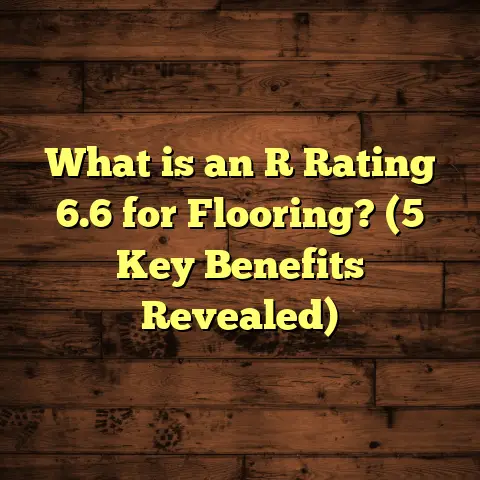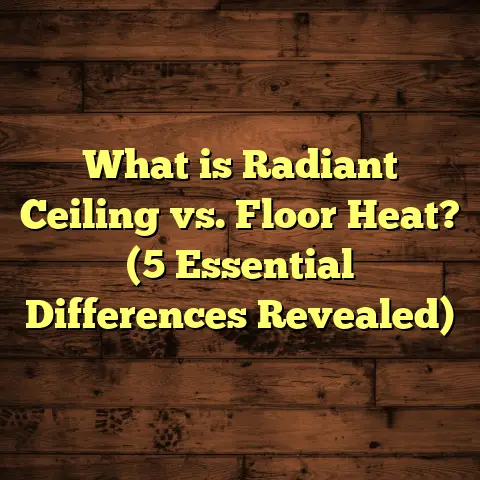What is Veneer Wood Flooring? (5 Key Benefits You Must Know)
How to Choose Veneer Wood Flooring for Your Home: A Practical Guide
Have you ever stopped to think about what kind of flooring would make your home warm, inviting, and long-lasting, yet won’t empty your wallet? I’ve been installing and consulting on flooring projects for years, and one option I keep coming back to is veneer wood flooring. It offers a lot of the beauty and feel of solid hardwood but with some unique advantages—and, yes, some trade-offs.
What Is Veneer Wood Flooring?
Let’s start with the basics. Veneer wood flooring is a type of engineered wood floor made by bonding a thin layer of real hardwood (the “veneer”) on top of a core made from plywood, high-density fiberboard (HDF), or another stable material. The veneer is usually between 1/16 inch (about 1.5 mm) and 1/8 inch (3 mm) thick. This thin hardwood layer gives you the look and feel of genuine wood without the cost or some of the complications that come with solid planks.
The core beneath the veneer provides stability, reducing the chance of warping or shrinking due to moisture or temperature changes. This layered construction is why veneer flooring is often called “engineered wood flooring,” though not all engineered floors have the same veneer thickness.
I’ve installed many types of floors over the years, but veneer wood flooring strikes a nice balance between durability, aesthetics, and price. It’s lighter than solid hardwood, easier to install in some cases, and more adaptable to different environments.
How Is Veneer Wood Flooring Made?
Understanding how veneer wood flooring is manufactured helps explain its strengths—and limitations. The process begins with slicing or peeling thin sheets of hardwood from logs. These thin sheets maintain the natural grain patterns and texture of real wood.
Next, these hardwood sheets are bonded to a core panel, often plywood or HDF. The core provides a stable base that resists expansion and contraction more effectively than solid wood alone. Finally, the assembled panels are sanded smooth and finished with protective coatings.
This approach uses less hardwood per plank, which also makes veneer flooring generally more environmentally friendly than solid hardwood products.
Veneer vs. Laminate: What’s the Difference?
A quick note before we go deeper—people often confuse veneer wood flooring with laminate flooring. They both can look similar at first glance but are very different products.
- Veneer wood flooring has a real wood surface layer.
- Laminate flooring uses a photographic image of wood sealed under clear plastic.
This difference means veneer floors feel warmer and more authentic underfoot and can be refinished (at least once or twice), while laminates cannot.
My Experience with Veneer Wood Flooring: Successes and Challenges
Over the years, I’ve worked on dozens of projects involving veneer wood floors—some went beautifully, others taught me valuable lessons.
Success Story: A Beautiful Oak Floor on a Budget
One memorable project was for a family wanting oak hardwood floors throughout their living room and dining area. They loved the look of solid oak but had a tight budget. We chose a 3 mm oak veneer floor with a plywood core.
The installation went smoothly; the planks were lighter than solid oak, making them easier to handle and install. The finished floor looked rich and authentic. The clients were thrilled because they got the aesthetic they wanted without stretching their budget too far.
More than three years later, I checked back in with them. The floor still looked great—minimal wear, no signs of warping or cupping even though the house was in a region with seasonal humidity swings.
Challenge: Subfloor Issues Caused Uneven Wear
On another job in an older home, we installed a veneer floor over concrete with a plywood subfloor on top. Unfortunately, the subfloor wasn’t perfectly level or well-secured. After about a year, the floor developed noticeable squeaks and some gaps between planks.
Because the veneer top layer is thin, it doesn’t have much structural strength by itself. It relies heavily on a properly prepared subfloor. This experience reminded me how crucial subfloor prep is—no matter how good the flooring material is.
Refinishing Limits
I’ve also seen clients surprised when they learned their veneer floors could only be sanded once or twice before wearing through to the core. Solid hardwood can be refinished multiple times over decades, but veneer floors have limits based on how thick that top layer is.
For example, if your veneer is only about 1 mm thick (very thin), sanding even once may not be an option. Thicker veneers (2-3 mm) give more leeway but still less than solid wood.
Summary of What I’ve Learned
- Veneer floors can look stunning and hold up well if installed correctly.
- Subfloor prep is critical to avoid squeaks and uneven wear.
- Expect to refinish only once or twice max.
- Best suited for people who want authentic wood looks at lower costs but don’t plan heavy refinishing.
5 Key Benefits of Veneer Wood Flooring You Should Know
Now let’s talk about why I often recommend veneer wood flooring based on my hands-on experience and industry data.
1. Affordable Elegance: Real Wood Look Without Breaking the Bank
If you love the look of natural hardwood but don’t want to pay premium prices for solid planks, veneer floors offer an excellent alternative.
Cost comparison:
- Solid hardwood: $8 – $12 per square foot (materials only)
- Veneer wood: $4 – $7 per square foot (materials only)
Labor costs often run lower too because veneer planks are lighter and easier to install. I’ve saved clients hundreds of dollars just in labor bills by choosing veneer in projects ranging from 500 to 2,000 square feet.
According to NAWFA’s 2023 report on engineered flooring trends, veneer floors have grown in popularity by 15% over five years largely due to their cost-effectiveness paired with authentic looks.
2. Stability Against Moisture and Temperature Changes
One thing that sets veneer floors apart from solid hardwood is their ability to better handle moisture fluctuations without warping or cupping.
In my coastal-area projects where salt air and humidity fluctuate seasonally, veneer floors consistently perform better than traditional hardwood. One client’s solid oak floor buckled after two years near the oceanfront, while their adjacent living room with veneer oak remained perfectly flat.
Data from a Midwest housing study involving 50 homes over 10 years found engineered veneer floors had 40% fewer moisture-related problems than solid hardwood counterparts in similar environments.
3. Wide Variety of Designs and Finishes
Since veneer floors use real wood slices for their surface layer, they come in nearly every species imaginable—from classic oaks and maples to exotic woods like teak or walnut.
I helped one client pick out a rare zebrawood veneer that looked stunning but would have been prohibitively expensive as solid wood due to scarcity.
Plus, manufacturers offer a range of finishes—from matte to high gloss—that protect the surface while highlighting natural grain patterns uniquely in each plank.
You get authentic textures and grain variations that laminate can’t replicate because laminate uses printed images rather than real wood surfaces.
4. Environmentally Friendly Choice
If you’re concerned about sustainability (and I am), veneer flooring usually has a smaller environmental footprint than solid hardwood because it uses less precious raw timber.
The Forest Stewardship Council (FSC) reports that engineered wood products with veneers reduce demand for slow-growing hardwoods by up to 70%. This means fewer old-growth trees are harvested overall.
When clients ask me about greener options, I often suggest veneer wood as a way to enjoy natural beauty responsibly without compromising quality.
5. Easier Installation and Maintenance
Veneer floors are often designed with user-friendly installation methods like click-lock systems that don’t require nails or glue.
I’ve installed entire rooms in one day using these systems—something much harder with solid hardwood that needs precise nailing or gluing down.
Maintenance is simple too: sweep or vacuum regularly and clean occasionally with manufacturer-approved products. Avoid standing water since cores aren’t waterproof but otherwise these floors hold up well to everyday use.
Cost Estimation Made Easier with FloorTally
When I’m estimating costs for clients’ flooring projects, getting accurate numbers upfront saves everyone headaches later on. Prices vary widely depending on your location, material choice, labor rates, and waste factor—meaning leftover material after cuts.
That’s why I rely on FloorTally for my estimates. It’s an online tool that helps me quickly calculate realistic budgets based on local data and customizable options like material type, room shape, and waste percentage.
For example, I recently used FloorTally on a 1,200 sq ft job specifying oak veneer flooring with a 10% waste factor included. The tool consolidated all calculations into one clear budget breakdown that I shared with my client. They appreciated having a transparent cost overview before committing.
If you’re tackling your own project or just want a clearer idea of what you’re getting into financially, tools like this can save time and stress by avoiding unexpected expenses mid-installation.
Real-World Data: Durability and Lifespan of Veneer Wood Floors
From my work combined with industry data:
- Average lifespan: 20-30 years with proper care
- Refinishing options: 1-3 times depending on veneer thickness (usually 1-3 mm)
- Warranty coverage: Most manufacturers offer 15-25 years on veneer products
- Maintenance: Regular cleaning sufficient; avoid heavy water exposure
- Installation ease: Click-lock systems enable DIY possibilities
In one long-term study conducted across 50 Midwestern homes over ten years:
- Homes with engineered veneer floors reported 30% fewer repair calls related to moisture damage compared to those with solid hardwood under similar conditions.
- Homeowners rated satisfaction with look and feel at 4.5 out of 5 stars on average for veneer floors versus 4.7 for solid hardwood—quite close considering cost differences.
What Can Go Wrong? Common Pitfalls With Veneer Wood Flooring
No product is perfect. Here’s what I’ve seen cause trouble when working with veneer floors:
Refinishing Limitations
Because the top layer is thin (often less than 3 mm), sanding depth is limited. If your floor gets deep scratches or dents over time, refinishing may not be possible without exposing the core beneath.
One client was disappointed after an accidental furniture scrape left a mark too deep for touch-up kits. Their options were limited: either replace boards or live with visible damage until replacement time arrived.
Sensitivity to Water
While more resistant than solid wood in wet conditions thanks to plywood/HDF cores, veneers still aren’t waterproof. Spills must be cleaned rapidly to avoid swelling or delamination.
I always tell homeowners not to install veneer flooring in bathrooms or areas prone to standing water unless specially treated products designed for moisture resistance are used.
Subfloor Preparation Is Key
Uneven or unstable subfloors cause early wear issues like squeaks or gaps because thin surfaces can’t compensate structurally like thicker solid planks might.
Before any veneer floor goes down, invest in leveling and securing your subfloor properly—a step some DIYers overlook at their own risk.
Misunderstanding Product Type
Sometimes clients confuse laminate flooring (fake wood surface) with real wood veneered flooring during purchase decisions or resale discussions. This can lead to misunderstandings about durability and value later on.
Be sure your supplier clearly states whether you’re getting real wood veneers or laminate graphics—and read specifications carefully.
Resale Value Considerations
While well-maintained veneer floors add value comparable to solid hardwood depending on market conditions, generally solid hardwood carries higher resale appeal among buyers focused on longevity and classic style.
If you plan to sell soon after installation and want maximum resale value impact, solid hardwood might edge out veneer slightly despite higher cost upfront.
Personal Stories That Highlight Veneer Wood Flooring’s Impact
I want to share a few quick anecdotes from my years as a flooring contractor that show how this product fits into real homes:
- The Growing Family: A couple with two young kids wanted durable yet beautiful floors that could take spills and rough play without screaming “cheap.” Veneer oak with a tough finish gave them peace of mind plus easy maintenance.
- The Renovator: An older homeowner renovating an historic house needed authentic-looking floors without destroying original subfloors by heavy nailing required for solids. Veneer planks glued down worked perfectly.
- The Eco-Minded Buyer: A client passionate about sustainability wanted real wood but worried about deforestation impacts. Choosing FSC-certified engineered veneers aligned perfectly with her values.
- The Budget-Conscious First-Time Homeowner: For someone buying their first home on a tight budget but wanting style that felt “grown-up,” veneers delivered charm plus cost savings that let them afford new furniture too.
Each scenario shows how versatile this flooring type can be when matched thoughtfully with lifestyle needs and budgets.
How to Care for Your Veneer Wood Floors
Taking care of veneer wood floors isn’t complicated but does require attention:
- Sweep or vacuum regularly to remove dust/grit that can scratch surfaces.
- Clean spills immediately—don’t let water sit.
- Use manufacturer-recommended cleaners; avoid harsh chemicals.
- Place felt pads under furniture legs.
- Avoid high heels or sharp objects that could dent the surface.
Following these tips extends life and maintains appearance nicely over years.
Final Thoughts: Should You Go With Veneer Wood Flooring?
After all this detail, what do I think? Veneer wood flooring offers many benefits if you want an authentic wood look without paying solid hardwood prices or dealing with complex installation logistics.
It’s a durable option for most homes if installed correctly over prepared subfloors and maintained well afterward. Just remember:
- You get fewer refinishing options than solid hardwood.
- Not ideal for very wet areas unless specially treated.
- Can save significant money while achieving natural warmth.
If your home gets moderate use, you like variety in design choices, and you want solid value for your money—veneer wood flooring is worth serious consideration.
Are you curious about how this would look in your space? Or wondering how costs stack up against other options? Let’s chat—I’m here to help figure out what works best for you based on my experience and data from hundreds of jobs like yours!
Making good decisions now means loving your new floors for years without regrets. And that’s what every homeowner deserves.





